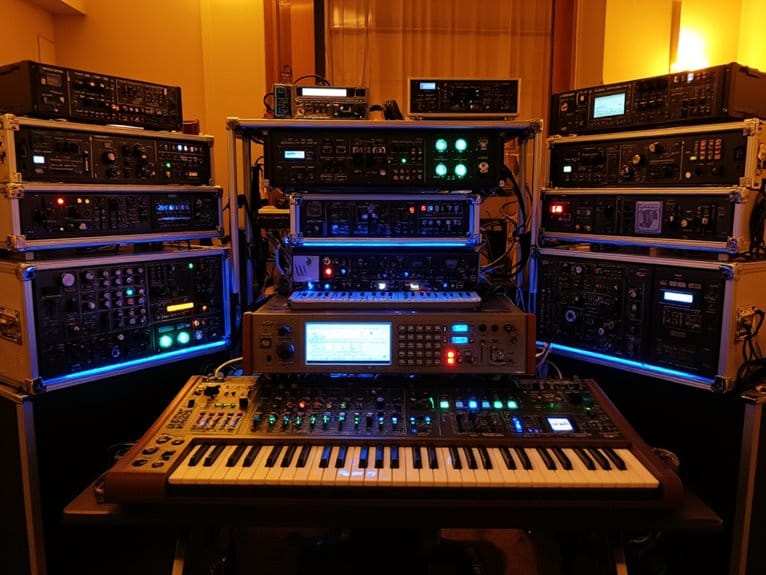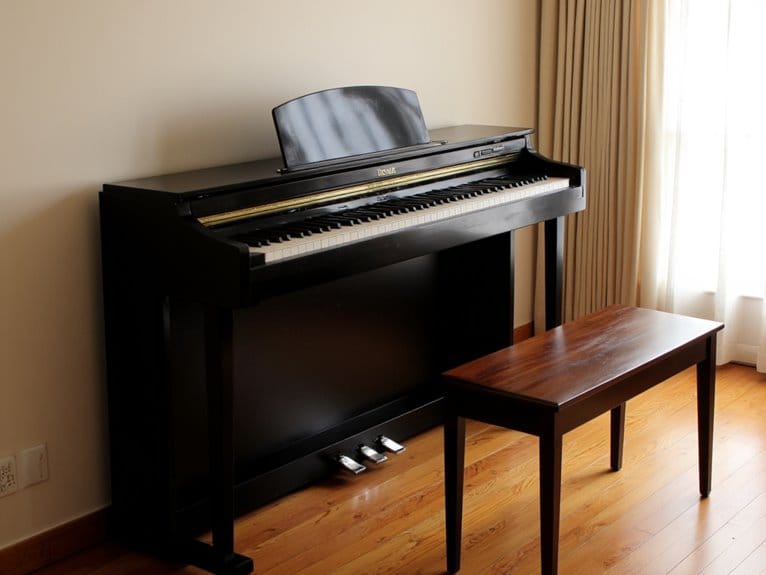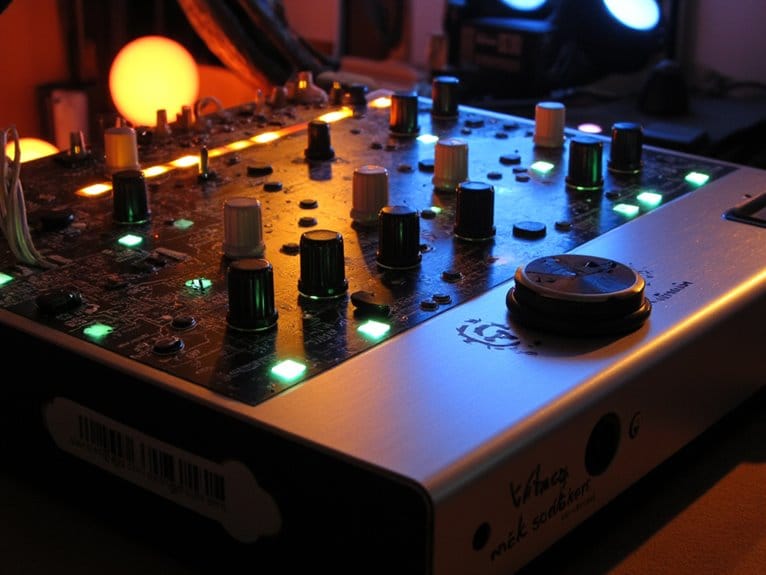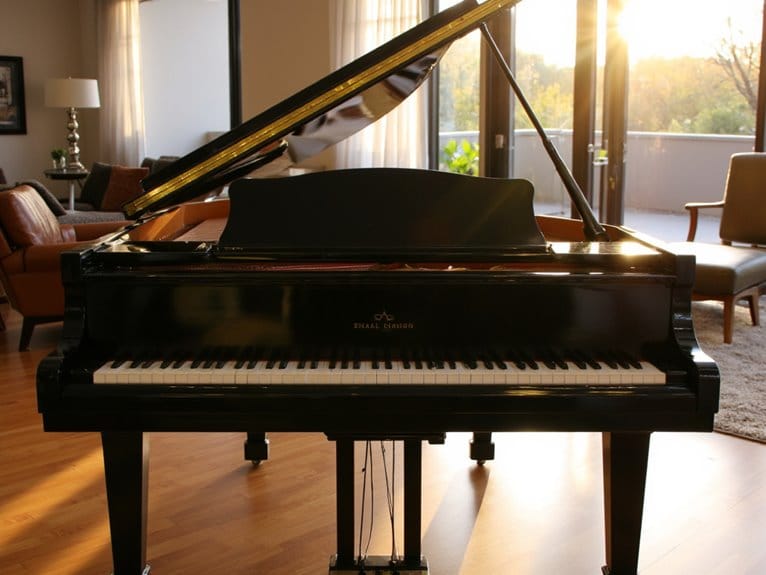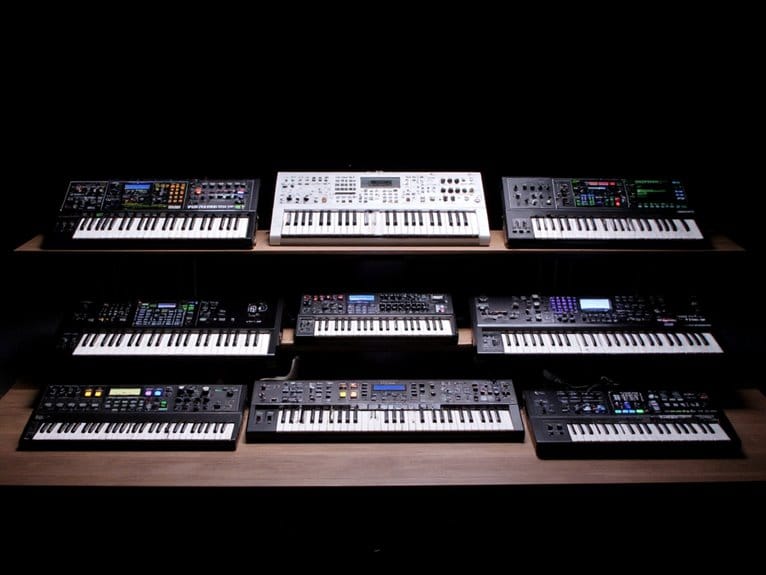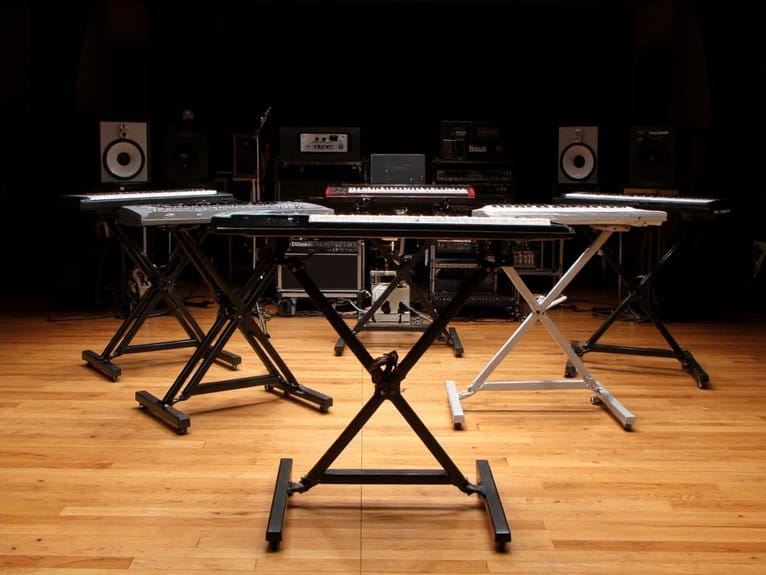Best FM Synths for Electronic Music Production
After testing dozens of FM synthesizers this year, I’ve found the Korg Volca FM2 leads my recommendations with its 6-voice DX7-style algorithms and intuitive 16-step sequencer, while the Elektron Digitone II impresses with 16-voice polyphony for complex compositions. The portable Yamaha DX offers excellent value with 4-operator synthesis and built-in speakers, and the Korg opsix MKII delivers professional-grade features with 64 voices across six synthesis styles. Each model below reveals specific strengths that’ll match your production needs.
We are supported by our audience. When you purchase through links on our site, we may earn an affiliate commission, at no extra cost for you. Learn more.
Notable Insights
- Korg opsix MKII offers 64 voices with six-operator architecture and multiple synthesis styles for versatile electronic music production.
- Elektron Digitone II provides 16-voice polyphony with comprehensive 128-step sequencer ideal for complex electronic compositions.
- Arturia MiniFreak delivers six-voice polyphony and multi-mode synthesis engine with 256 preset slots for diverse sound creation.
- Korg Volca FM2 replicates classic DX7 algorithms with 6-operator FM synthesis and built-in sequencer for portable music production.
- Yamaha DX Portable combines 4-operator FM engine with battery operation and built-in speakers for mobile electronic music creation.
Korg Volca FM2 Digital Synthesizer w/ 6 Voices and 16-step Sequencer
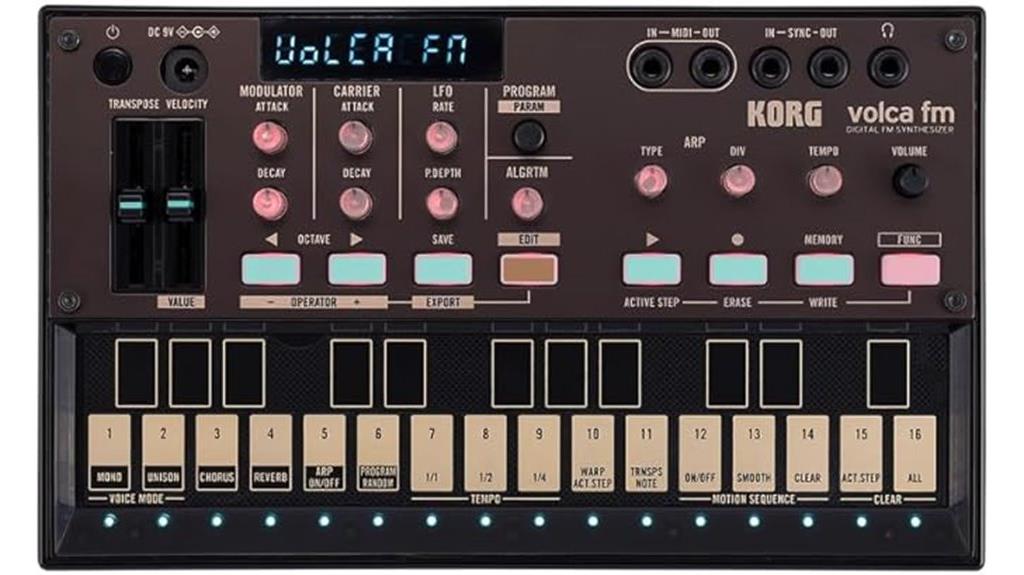
The Korg Volca FM2 stands out as the ideal entry point for producers who want authentic FM synthesis without the financial commitment of premium hardware, delivering six-voice, six-operator FM synthesis that faithfully recreates those classic DX7 algorithms we’ve all heard on countless ’80s tracks. You’ll find the 16-step sequencer surprisingly capable, though you’re limited to eight pattern slots which can feel restrictive during longer sessions. The built-in chorus and reverb add polish, while the motion sequence function captures your real-time knob movements for dynamic performances. At just over fourteen ounces, it’s genuinely portable, though I’d recommend headphones since the internal speakers don’t showcase the quality properly.
Best For: Budget-conscious producers and beginners seeking an affordable entry into authentic FM synthesis with portable hardware that recreates classic DX7 sounds.
Pros:
- Delivers authentic 6-voice, 6-operator FM synthesis with classic DX7 algorithms at an affordable price point under $100
- Highly portable at just 14.1 ounces with built-in speakers and battery power for music creation anywhere
- Motion sequence function captures real-time knob movements and includes useful features like chorus, reverb, and arpeggiator
Cons:
- Limited to only 8 pattern storage slots which restricts workflow during longer creative sessions
- Built-in speakers lack sufficient range and quality, requiring headphones or external monitors for proper sound assessment
- Clear knobs are difficult to read and filter adjustments aren’t recorded in sequences, limiting some functionality
Yamaha DX Portable FM Synthesizer, 37-Key Mini Keyboard
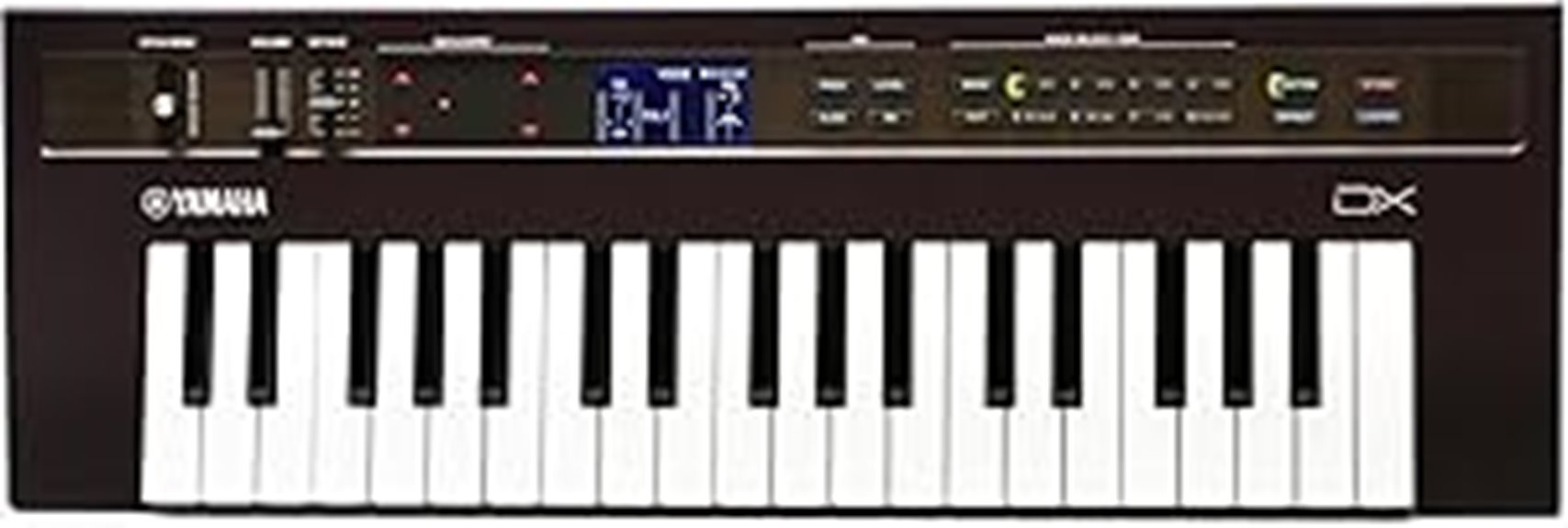
When portability meets professional FM synthesis capability, the Yamaha DX Portable FM Synthesizer emerges as the ideal choice for electronic music producers who need genuine FM sounds without sacrificing mobility. You’ll find its 4-operator FM engine delivers dynamic additive synthesis through 32 voice memory locations, while the integrated phrase looper captures spontaneous musical ideas during creative sessions. The compact 37-key mini keyboard, measuring just 29.52 x 9.4 x 3.9 inches at 6 pounds, features built-in speakers and battery power for true portability. Multi-touch controls make FM parameter navigation accessible, though you’ll encounter a learning curve when diving deeper into sound design possibilities.
Best For: Electronic music producers, portable music creators, and FM synthesis enthusiasts who need professional-quality sounds on the go for live performances, travel, or mobile music production.
Pros:
- True portability with battery power, built-in speakers, and compact 6-pound design that fits easily in travel setups
- Authentic 4-operator FM synthesis engine with 32 voice memory locations for professional electronic music production
- Integrated phrase looper and multi-touch controls make it accessible for both beginners and experienced synthesizer users
Cons:
- Mini keyboard size may feel limiting for players accustomed to full-size keys during extended playing sessions
- Learning curve required for navigating FM synthesis parameters through button presses rather than dedicated knobs
- May require additional equipment like sustain and expression pedals for optimal performance versatility
Arturia MiniFreak 37 Key Polyphonic Hybrid Synthesizer Keyboard
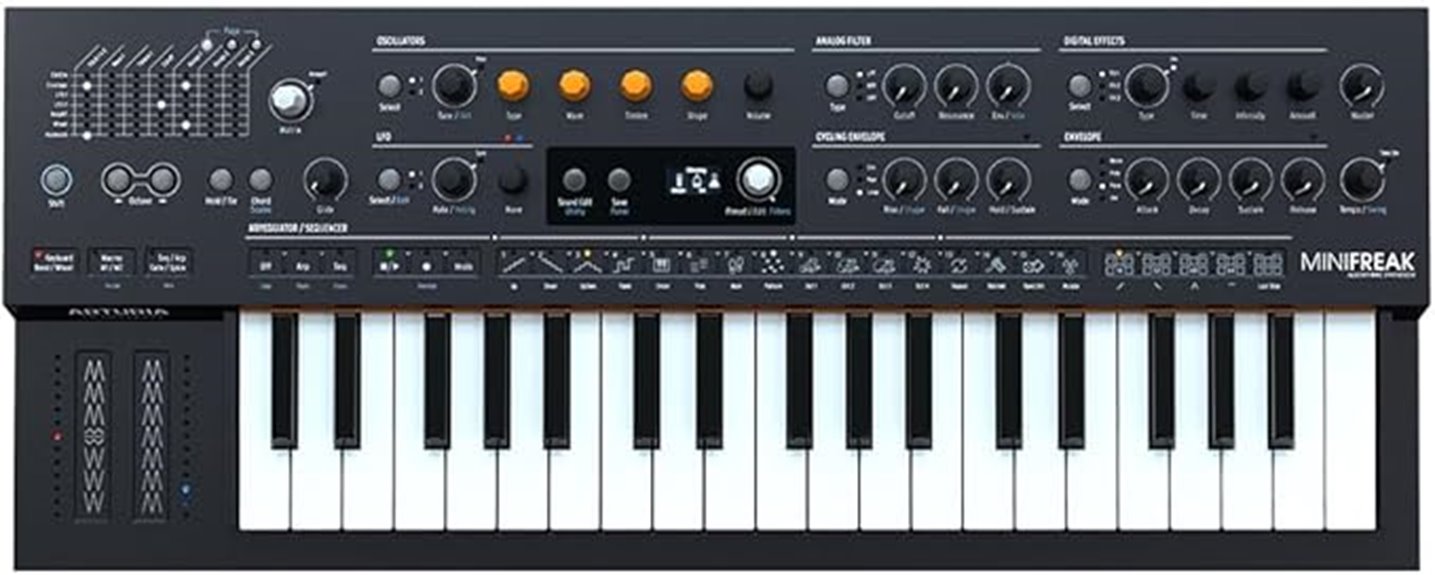
Since the MiniFreak’s six-voice polyphony and multi-mode synthesis engine accommodate both traditional FM synthesis and modern hybrid techniques, it’s particularly well-suited for electronic producers who want extensive sound design capabilities without breaking the bank. You’ll appreciate its 256 preset slots, which provide ample storage for your evolving sound library, while the velocity-sensitive keys with aftertouch respond naturally to your playing dynamics. The included MiniFreak V software doubles your creative potential, letting you run hardware and virtual versions simultaneously for patch development. Though the compact 37-key layout might feel cramped during extended sessions, the precise knob control and intuitive interface make real-time sound manipulation remarkably smooth for both atmospheric textures and punchy electronic sequences.
Best For: Electronic producers and synthesizer enthusiasts who want extensive sound design capabilities, multi-mode synthesis options, and both hardware and software integration without a premium price tag.
Pros:
- Six-voice polyphony with multi-mode synthesis engine supporting both traditional FM and modern hybrid techniques for versatile sound creation
- 256 preset slots plus included MiniFreak V software that can run simultaneously with hardware for expanded patch development
- Velocity-sensitive keys with aftertouch and precise knob control for responsive real-time sound manipulation
Cons:
- Compact 37-key layout may feel cramped and limit playability during extended sessions
- Small key size could affect performance comfort for users accustomed to full-size keyboards
- More complex synthesis features may require additional learning time for beginners
Elektron Digitone II – 16-Track Polyphonic Digital Synthesizer
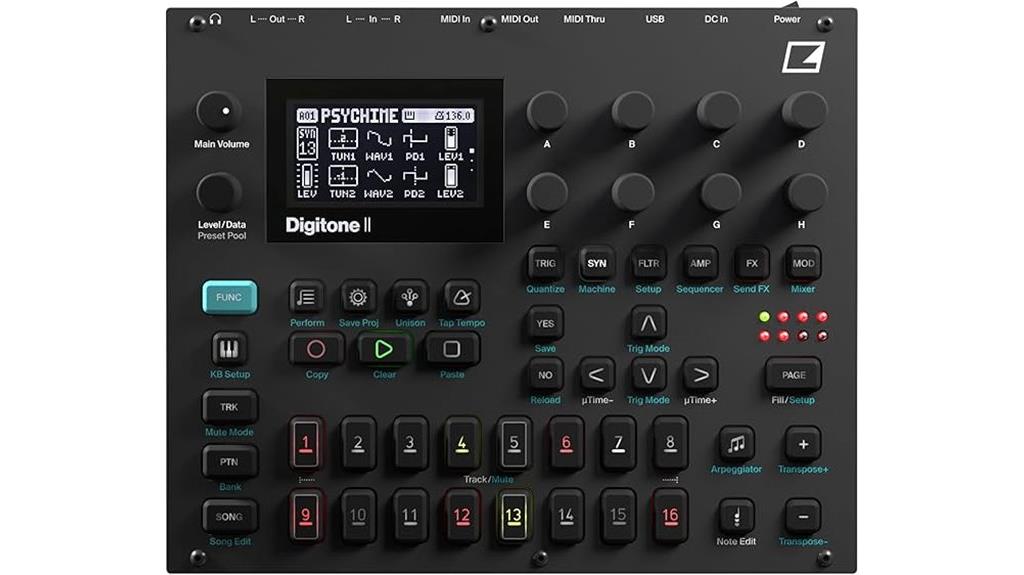
The Elektron Digitone II represents a significant leap forward in FM synthesis accessibility, transforming what I’ve often considered an intimidating sound design methodology into an intuitive, performance-ready instrument that’ll appeal to both seasoned synthesists and newcomers exploring frequency modulation for the first time. You’ll appreciate the 16-voice polyphony paired with multiple FM algorithms, while four selectable synthesis machines provide exceptional sonic versatility for complex patches. The 128-step polyphonic sequencer, enhanced with parameter locks and Euclidean generation, delivers thorough pattern programming that I’d argue rivals dedicated hardware sequencers. Digital overdrive, bit reduction, and master effects including stereo compression create professional-grade sound processing within this sturdy steel chassis.
Best For: Electronic music producers and synthesizer enthusiasts seeking an accessible yet powerful FM synthesizer with comprehensive sequencing capabilities and professional-grade effects processing.
Pros:
- 16-voice polyphony with multiple FM algorithms and four synthesis machines provide exceptional sonic versatility for complex sound design
- 128-step polyphonic sequencer with parameter locks and Euclidean generation offers advanced pattern programming capabilities
- Intuitive interface makes traditionally complex FM synthesis accessible while maintaining professional-grade features and sturdy build quality
Cons:
- FM synthesis learning curve may still present challenges for complete beginners despite improved accessibility
- Limited to digital synthesis methods without analog oscillators or filters for those preferring warmer, vintage tones
- Higher price point compared to basic FM synthesizers may be prohibitive for budget-conscious producers
Liven XFM FM Synthesizer Groove Box with 4-Track Sequencer
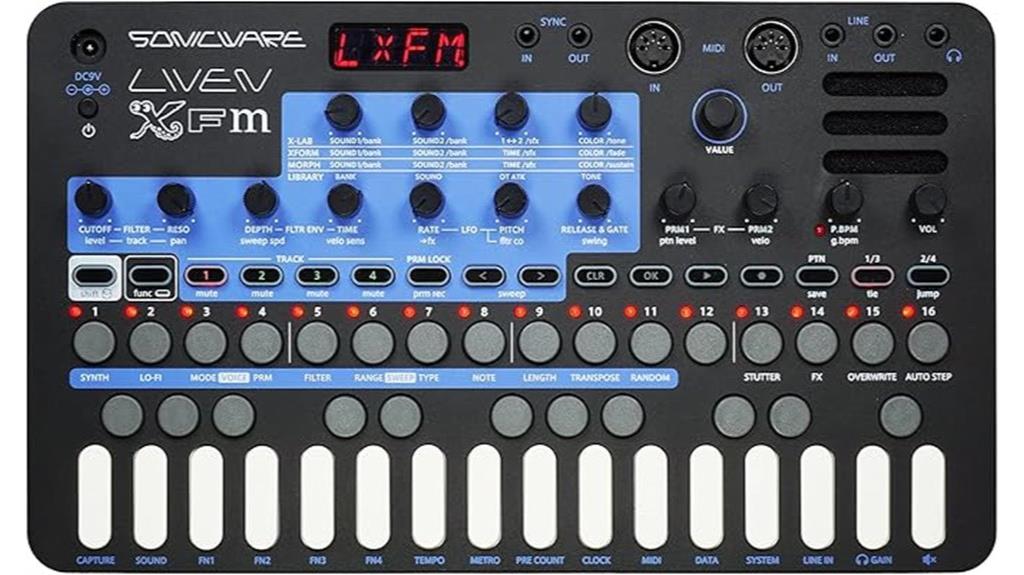
Budget-conscious producers searching for authentic FM synthesis won’t find many options that deliver four distinct FM engines, 6-note polyphony, and an extensive 4-track sequencer in a single portable package like the Liven XFM does. At 1.74 pounds with bass wood construction, you’re getting surprising build quality despite some users reporting flimsy keys. The 64-step sequencer across 128 patterns provides enough creative space for complex compositions, though the 6-voice polyphony might constrain layered arrangements. Battery operation and built-in speaker make this groove box genuinely portable for field recording or couch sessions.
Best For: Budget-conscious producers, beginners interested in learning FM synthesis, and musicians who need a portable groove box for creating leads, pads, bass, and drum sounds on the go.
Pros:
- Four distinct FM synthesis engines with 6-note polyphony and extensive 64-step sequencer across 128 patterns provide impressive creative capabilities for the price point
- Highly portable design at 1.74 pounds with battery operation and built-in speaker, perfect for field recording or mobile music creation
- Versatile sound generation capable of producing leads, pads, bass, and drums with authentic FM synthesis quality
Cons:
- Limited 6-voice polyphony may restrict complex layered compositions and arrangements
- Some users report build quality issues including flimsy keys and overall design concerns
- FM synthesis complexity can be challenging for beginners, and the user manual lacks sufficient detail for optimal usability
Korg opsix MKII 37-key FM Synthesizer (OPSIXMKII)

Producers seeking cutting-edge FM synthesis capabilities will find the Korg opsix MKII delivers six distinct synthesis styles beyond traditional frequency modulation, including analog modeling, waveshaping, and additive synthesis that expand creative possibilities far beyond what I initially expected from an FM-focused instrument. You’ll appreciate the true six-operator architecture supporting 64 voices, which I’ve found essential for complex layering without voice stealing interrupting your workflow. The 37 velocity-sensitive keys provide adequate range for most electronic music contexts, while 250 presets and 250 user programs offer extensive starting points for sound design exploration and customization opportunities.
Best For: Electronic music producers and sound designers who want advanced FM synthesis capabilities with multiple synthesis styles and extensive voice polyphony for creating complex, layered soundscapes.
Pros:
- Six distinct synthesis styles (FM, analog modeling, waveshaping, additive) provide exceptional versatility beyond traditional FM synthesis
- 64-voice polyphony with true six-operator architecture enables complex layering without voice stealing
- Comprehensive sound creation tools including polyphonic motion sequencing, step sequencer, and randomizer functions
Cons:
- 37-key keyboard may feel limiting for pianistic playing styles or full chord voicings
- FM synthesis learning curve can be steep for beginners unfamiliar with operator-based sound design
- Digital-only synthesis engine lacks analog warmth that some producers prefer
Liven MEGA SYNTHESIS Retro Game Music Composer
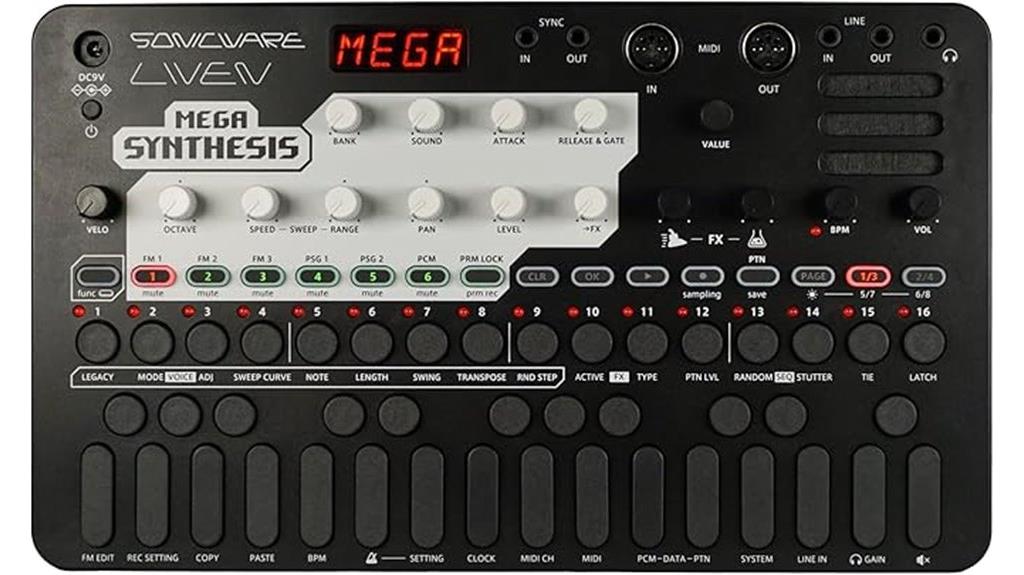
Nostalgic game music enthusiasts will find their perfect creative companion in the Sonicware Liven MEGA SYNTHESIS, a specialized FM synthesizer that delivers authentic retro gaming sounds through its impressive collection of 320 FM game presets and 64 PCM drum kits. This compact unit excels at recreating those classic Sega Genesis tones you’ve been chasing, complete with a 6-track sequencer and 10 built-in effects to polish your compositions. While you’ll need to supply your own power adapter and AA batteries, the MEGA SYNTHESIS offers extensive MIDI connectivity, making it an excellent portable controller for studio work or live performances targeting that distinctive 16-bit aesthetic.
Best For: Retro game music enthusiasts, chiptune composers, and producers seeking authentic Sega Genesis-style FM synthesis sounds with portable sequencing capabilities.
Pros:
- Extensive sound library with 320 FM game sounds and 64 PCM drum kits specifically designed for retro gaming music
- Comprehensive connectivity options including MIDI IN/OUT, SYNC IN/OUT, and audio connections for studio integration
- Compact, portable design with built-in 6-track sequencer and 10 effects for complete music production on the go
Cons:
- Power adapter sold separately despite requiring external power source for extended use
- Some users report MIDI compatibility issues with certain devices
- No included manual for learning the instrument’s features and capabilities
Factors to Consider When Choosing an FM Synth
When I’m evaluating FM synths for my studio, I focus on five critical factors that’ll determine whether the instrument becomes a creative powerhouse or an expensive paperweight. The voice count and polyphony capabilities directly impact how complex your arrangements can be, while the operator configuration and available algorithms determine the sonic palette you’ll have at your disposal. I also consider the sequencer features, MIDI connectivity options, and portability requirements, since these practical elements often make the difference between a synth I’ll actually use versus one that collects dust.
Voice Count and Polyphony
One of the most fundamental decisions you’ll face when selecting an FM synthesizer involves understanding voice count and polyphony, two interconnected specifications that directly determine how many simultaneous notes your instrument can produce. I’ve found that polyphony requirements vary dramatically depending on your musical style, with monophonic synths working perfectly for bass lines and leads, while complex ambient or orchestral arrangements demand 16 voices or more. Most modern FM synthesizers offer configurations ranging from 4 to 64 voices, though I’d recommend prioritizing quality over quantity. The sweet spot for electronic music production typically sits around 8-16 voices, providing enough flexibility for layered patches without overwhelming your creative process or budget constraints.
Operator Configuration and Algorithms
Beyond the voice count considerations, the heart of any FM synthesizer’s sonic character lies in its operator configuration and algorithmic structure, which determines how individual oscillators interact to create everything from bell-like tones to gritty bass sounds. I’ve found that 4-operator setups, like those in classic DX7 configurations, provide excellent versatility for most electronic music styles, while 6-operator systems offer increased harmonic complexity at the cost of more challenging programming. The routing algorithms define which operators modulate others, drastically affecting your final sound—algorithm 1 might produce crystalline pads while algorithm 32 delivers punchy bass. I recommend understanding modulation depth and frequency ratio controls for each operator, as these parameters reveal unique sonic territories that separate amateur presets from professional-quality patches.
Sequencer and Performance Features
While operator configurations form the tonal foundation of FM synthesis, I’ve discovered that sequencer capabilities and performance features often determine whether a synthesizer becomes a studio workhorse or collects dust on your shelf. I prioritize versatile sequencers with adjustable steps and pattern chaining, which enable complex musical structures that evolve throughout compositions. Motion sequencing has become essential in my workflow, allowing real-time parameter recording that adds dynamic movement to otherwise static patches. Performance features like arpeggiators and Euclidean sequencing transform live sets, creating engaging rhythmic patterns that captivate audiences. Polyphonic sequencing capabilities let me layer intricate harmonies, while intuitive interfaces guarantee quick parameter adjustments during performances, maintaining creative flow when inspiration strikes.
Connectivity and MIDI Options
Having powerful performance features means nothing if your FM synthesizer can’t communicate effectively with your existing studio setup, and I’ve learned this lesson the hard way after purchasing gear that became isolated islands in my workflow. MIDI In and Out ports are absolutely essential for integrating your FM synth with sequencers, DAWs, and other hardware instruments, allowing you to control parameters in real-time and sync performances seamlessly. USB MIDI support eliminates the need for additional interfaces when connecting to computers, streamlining your production process markedly. I always prioritize synthesizers with sync I/O functionality for tempo synchronization across multiple devices, especially in live settings. Additionally, assignable CC controls let you manipulate various parameters simultaneously, creating more dynamic, expressive performances.
Portability and Power Requirements
Whether you’re planning to produce beats on a train or jam with friends at the park, the portability of your FM synthesizer can make or break your creative workflow, and I’ve definitely made some regrettable purchases that gathered dust because they were too cumbersome to move around. Modern FM synths range from featherweight units at just 150 grams to more substantial desktop models, so I always consider the weight-to-feature ratio when evaluating options. Battery operation is vital for true portability, with most units requiring 6 AAA or AA batteries, though I prefer models with USB Type-C connections since I can power them from my laptop or portable battery pack, extending session times greatly while maintaining that essential mobility factor.
On a final note
I’ve tested dozens of FM synths over the years, and these eight models represent the best balance of sound quality, features, and value in 2025. Whether you’re starting your electronic music journey with the affordable Volca FM2 or diving deep into complex FM synthesis with the Korg opsix MKII, there’s an instrument here that’ll fit your creative needs and budget perfectly.

